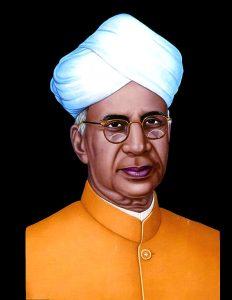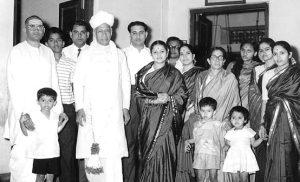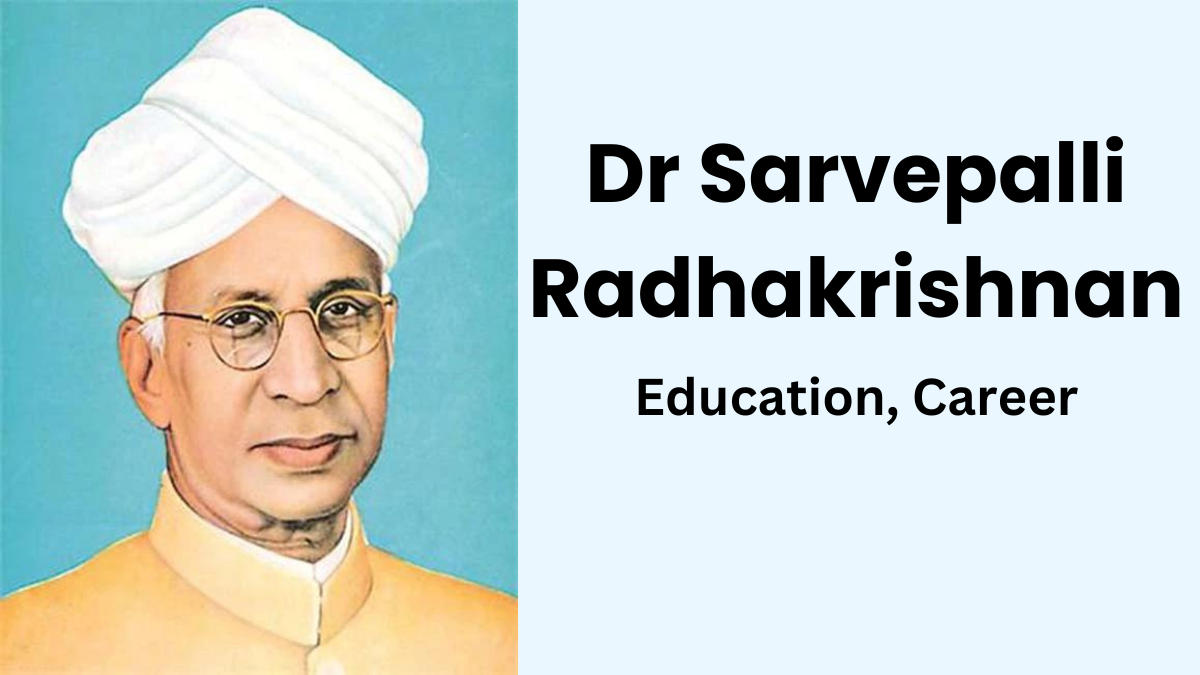Table of Contents
Biography of Sarvepalli Radhakrishnan
Dr. Sarvepalli Radhakrishnan was a highly respected Indian philosopher, scholar, and statesman who made significant contributions to the intellectual and political landscape of India. Dr. Sarvepalli Radhakrishnan was born on 05 September 1888, in Tiruttani, Tamil Nadu, he has emerged as a prominent academic figure known for his profound insights into philosophy, particularly in the areas of comparative religion and Indian philosophy.

- Dr. Radhakrishnan’s illustrious career included serving as the first Vice President of India from 1952 to 1962 and subsequently as the second President of India from 1962 to 1967. Before entering the realm of politics, he achieved distinction as an educator, holding key positions such as Vice-Chancellor of Andhra University and Banaras Hindu University.
- His dedication to knowledge and culture earned him the honor of being a Knight of the Order of the Star of India, and he received numerous awards and accolades for his contributions to philosophy and education. Dr. Sarvepalli Radhakrishnan’s legacy endures through his profound influence on Indian thought.
Sarvepalli Radhakrishnan Early Life
Dr. Sarvepalli Radhakrishnan was born on 05 September 1888, into a Telugu-speaking Niyogi Brahmin family in Tiruttani, which was part of the Madras Presidency during British India and is now located in Tamil Nadu, India. His parents were Sarvepalli Sita and Sarvepalli Veeraswami, the latter being a subordinate revenue official serving a local zamindar.
The roots of his family can be traced back to Sarvepalli village in Andhra Pradesh’s Nellore district. Radhakrishnan spent his formative years growing up in the cities of Thiruttani and Tirupati and received several scholarships that supported his educational journey.
| Dr. Sarvepalli Radhakrishnan’s Early Life | |
| Born | 05/09/88 |
| Religion | Hinduism |
| Place of Birth |
Thiruttani, Madras Presidency, British India (now in Tamil Nadu, India)
|
| Nationality | Indian |
| Father | Sarvepalli Veeraswami |
| Mother | Sitamma |
| Died |
17 April 1975 (aged 86) Madras (now Chennai), Tamil Nadu, India
|
| Spouse Name | Sivakamu, Lady Radhakrishnan |
| Children | Five daughters and One son |
| Education |
|
Death Of Servepalli Radhakrishnan
- He spent the last 8 years in Mylapore, Madras.
- On 17 April 1975, Dr Radhakrishnan passed away.
Dr. Sarvepalli Radhakrishnan Education
- Sarvepalli Radhakrishnan had completed his primary education at K.V. High School in Thiruttani.
- He had continued education at Government High Secondary School in Walajapet and Hermannsburg Evangelical Lutheran Mission School in Tirupati in 1896.
- Enrolled at Voorhees College in Vellore to complete high school.
- Applied to Madras Christian College at the age of 17.
- Dr Radhakrishnan joined Madras Christian College in the year of 1904, and after this in the year 1906 he gained interest in law sector.
- His bachelor’s thesis, titled “The Ethics of the Vedanta and its Metaphysical Presuppositions,” was crafted to address and counter criticisms of the ethical principles strong Vedanta philosophy
- Received high marks from his teachers, Rev. William Meston and Dr. Alfred George Hogg, for his dissertation, which was published when he was just twenty years old.
Dr. Sarvepalli Radhakrishnan Family
Dr. Sarvepalli Radhakrishnan was born in Tirana, Tamil Nadu, on September 5, 1888. He was the second of five children born to Sarvepalli Srinivasa Iyer and Parvathi Ammal. His father was a school teacher and his mother was a homemaker. Radhakrishnan had a close relationship with his family and they were a great source of support for him throughout his life.
Radhakrishnan’s wife, Sivakami Ammal, was a devout Hindu and a strong supporter of her husband’s career. She was also a talented poet and writer. The couple had two daughters, Saroja and Lakshmi. Radhakrishnan’s family was a close-knit unit that provided him with love, support, and inspiration. They were a major force in his life and helped him to achieve great things.

Here are some additional details about Radhakrishnan’s family:
- His father, Sarvepalli Srinivasa Iyer, was a Sanskrit scholar and a teacher. He was a major influence on Radhakrishnan’s interest in philosophy and religion.
- His mother, Parvathi Ammal, was a housewife and a devout Hindu. She was a loving and supportive mother who encouraged her son to pursue his dreams.
- His wife, Sivakami Ammal, was a talented poet and writer. She was also a devout Hindu and a strong supporter of her husband’s career.
- His daughters, Saroja and Lakshmi, were both educated and accomplished women. Saroja became a professor of English and Lakshmi became a social worker.
Sarvepalli Radhakrishnan’s Political Career
- Dr. Sarvepalli Radhakrishnan’s journey into politics began later in life after a promising academic career. His interest in politics grew due to his involvement in international affairs. In 1928, he attended the Andhra Mahasabha, where he supported renaming the Ceded Districts division of the Madras Presidency to Rayalaseema.
- Radhakrishnan gained recognition on the global stage when he was nominated to the League of Nations Committee for Intellectual Cooperation in 1931. He became known as an expert in Hinduism and Indian thought, bridging the gap between Eastern institutions and Western understanding. After India gained independence, Radhakrishnan became actively engaged in both national and international politics.
- He served as the chairman of the Indian delegation to UNESCO from 1946 to 1951, participated in the Indian Constituent Assembly, and was appointed India’s ambassador to Moscow until 1952. Later, he was elected to the Rajya Sabha and eventually became India’s first vice president in 1952 and the second president in 1962.
- During his tenure, he emphasized world peace and intergroup harmony, even amidst political challenges like the conflict with China and hostilities with Pakistan. Radhakrishnan advocated for a more inclusive and metaphysical approach to international relations, promoting tolerance and respect for different cultures and nations.
Why is 5 September celebrated as Teachers Day?
- September 5th is celebrated as Teacher’s Day in India to honor the birth anniversary of Dr. Sarvepalli Radhakrishnan, a renowned Indian philosopher, scholar, and statesman. Dr. Radhakrishnan was not only an exceptional educator but also a distinguished leader who served as the first Vice President (1952-1962) and the second President (1962-1967) of India.
- In a gesture of respect and gratitude, when he became President, he suggested that instead of celebrating his birthday, September 5th should be dedicated to celebrating teachers. This day serves as a tribute to the invaluable role teachers play in shaping the minds and future of students, acknowledging their dedication, and recognizing their impact on society.
- As we talked about his works in comparative religion and philosophy, while starting with this article, it should be noted that he is also author to the following books :
- The Philosophy of Rabindranath Tagore (1918)
- Indian Philosophy (Volume 1 – 1923, Volume 2 – 1927)
- The Hindu View of Life (1926)
- The Reign of Religion in Contemporary Philosophy (1920)
- Eastern Religions and Western Thought (1939)
- An Idealist View of Life (1932)
- Gautama the Buddha(1948)
- The Principal Upanishads (1953)
- Recovery of Faith(1956)
- Religion and Society (1947)
- Religion, Science and Culture(1947)
- The Brahma Sutra: The Philosophy of Spiritual Life (1953)
- A Source Book in Indian Philosophy (1957) – Co-authored with Charles A. Moore
- East and West: Some Reflections(1956)
- Fellowship of the Spirit (1966)
Teacher’s Day is marked by various events, ceremonies, and activities in educational institutions across India to honor and appreciate the hard work and dedication of educators.
| Relatable Articles | |
| Chandra Shekhar Azad | Birsa Munda |
| Lala Lajpat Rai | Mangal Panday |
| Homi Jahangir Bhabha | Pandit Jawaharlal Nehru |



 TSPSC Group 1 Question Paper 2024, Downl...
TSPSC Group 1 Question Paper 2024, Downl...
 TSPSC Group 1 Answer key 2024 Out, Downl...
TSPSC Group 1 Answer key 2024 Out, Downl...
 UPSC Prelims 2024 Question Paper, Downlo...
UPSC Prelims 2024 Question Paper, Downlo...




